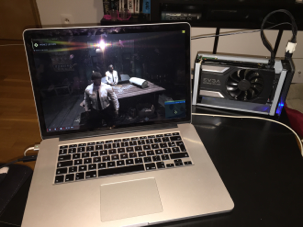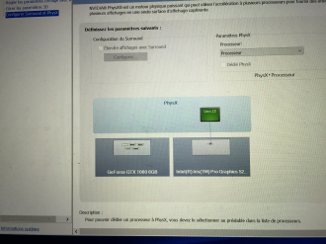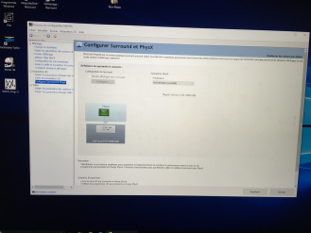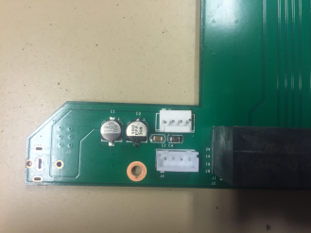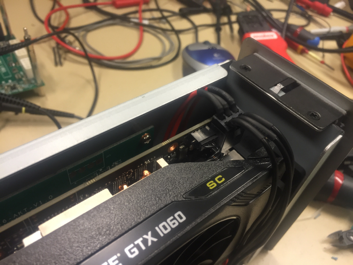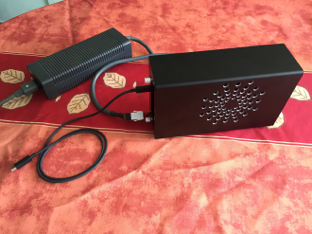Search the Community
Showing results for tags 'optimus'.
-
Hey guys, Let me introduce you my eGPU setup, realized on a 2013 15" retina Macbook Pro, model equipped with a dedicated GT 750M. I am using an Akitio Thunder2 PCIe enclosure and a EVGA Geforce GTX 1060 SC 6Gb. I wanted to use both internal and external display on my Mac. I was looking for information during weeks before buying it and wasn’t really sure if it would work as I wanted to. Many people are convinced that using the internal screen is impossible or way more complicated if the Mac has a dedicated GPU. I spend a whole week formatting and testing, using UEFI, BIOS, considering going back to Windows 7 (not for long)… I finally used Windows 10 UEFI, the programs rEFInd and GPU-switch and nothing else ! No need for an HDMI headless ghost or any program to spoof the number of screens. I made a video to show you the whole installation process, I hope that it will help: My GF did the voice acting as I wasn't convinced by my own If you prefer a text-based tutorial, here are the different steps: 1) Installation of Windows 10 in UEFI mode On the 2013 retina Macbook Pro, the SSD is a PCIe model. This seems related to the UEFI mode used by default when using the Boot camp assistant. If you don’t want to use it or are using another model of Macbook, you can follow this excellent tutorial to force the UEFI mode: http://fgimian.github.io/blog/2016/03/12/installing-windows-10-on-a-mac-without-bootcamp/ You just need to create a conventional partition and convert your table partition from “hybrid” to “protective”. By doing this, Windows will see a GPT disk instead of MBR. You just need to boot your USB drive on EFI mode. Once Windows is properly installed with the correct Macbook drivers (another reason to prefer the boot camp assistant), you need to go back to Mac OS. 2) Installing rEFInd rEFInd is a boot manager tool, like rEFIt or GRUB. Its first advantage is the ability to choose the OS without the need to press a key at startup. And the real reason why we are using it is to spoof the computer to allow Windows seeing the entire installed hardware. You can install refind from this link: http://www.rodsbooks.com/refind/ Then you need to activate this spoof ability by opening a terminal and typing these two commands: sudo mkdir /Volumes/efi sudo mount -t msdos /dev/disk0s1 /Volumes/efi Now, you can see your EFI partition in your Finder. Go to EFI/EFI/refind and open the file refind.conf with textedit. Search for the “spoof OS version” and remove the comment symbol # Reboot your computer and choose Windows on the rEFInd screen. Open your device manager, you’ll see your iGPU (intel iris pro graphics 5200) and dGPU (Geforce GT 750M) 3) gpu-switch GPU-switch can be downloaded from there: https://github.com/0xbb/gpu-switch Download the windows version, available in the description (direct link : https://github.com/0xbb/gpu-switch/releases/download/v0/gpu-switch-windows.zip ) Install Microsoft C++ redistributable (not sure which version do the trick, I’ve installed each version in x64 and x86 just to be sure) open the file integrated.bat with administrator rights, you should see the word “success” 4) GPU driver installation Not sure if this step is necessary but I’ve removed the dGPU driver before installing nVidia GeForce experience. The program DDU (Display Driver Uninstaller) is perfect for that. You can download it using this link: http://www.guru3d.com/files-details/display-driver-uninstaller-download.html Choose to uninstall and shutdown the computer, as you will install a new hardware indeed When your computer is off, plug the power supply to your eGPU, press the computer power button, wait for the chime and the rEFInd screen to appear, then plug your eGPU to the Macbook and launch Windows. If rEFInd is stucked, hold the power button until the computer is off. You should now see three graphics cards in the device manager, two of them not recognized at this point. Install nVidia GeForce experience and the latest nVidia driver. The GPU list will be updated at the end of the installation process. Re-launch GPU-switch and reboot. You don’t need to unplug the eGPU when rebooting. Now, your eGPU should have an error code 12, with unsufficient resources available. Just right clic on the dGPU (GT 750M) and disable it. Re-launch gpu-switch just to be sure (integrated.bat) and reboot. Just a last step and you’ll good to go Right click on the nVidia icon in your systray and open the configuration panel. Go to PhysX and set it to automatic instead of processor, like on this picture: That’s it, you can now launch your games on the internal screen or using an external monitor To switch between both, just plug the display on the eGPU and use the shortcut Win + P (Cmd + P on a Mac keyboard) to toggle between both screens. You can also duplicate them, it works, but don’t expect any kind of good performances doing this Now, the most important part, to avoid screwing your configuration: every time you go back to Mac OS, Windows will switch to the dedicated GPU (maybe also when turning off the computer, I’m not sure). For this reason, always re-enable the GT 750M before turning off the computer! Otherwise, you’ll get a black screen at Windows startup. Just follow this procedure when you want to use your eGPU: - Use gpu-switch to set the integrated GPU as primary - Disable the dGPU from the device manager - Turn off your computer or reboot - When you see the reEFInd screen, plug your eGPU and launch Windows - Play you favorite video game or launch your intensive GPU application (there are two schools) - Re-enable your dGPU from the device manager - Turn off your computer - Unplug your eGPU Now, some advices based on my little experience: If your end up with a black screen, you can restore Windows to a previous restauration point or remove the display driver. If you really can’t boot windows, using Parallels Desktop, you can boot your Windows partition from a virtual machine, then remove the display driver. At first, I was experiencing a game crash and the GPU fan running at max speed, when launching any sort of game. This issue was caused by the power supply connection, using an Xbox 360 S adapter with too thin wires These wires caused a voltage drop when consuming the 100W needed when playing a game (against 15W on Windows) About the electrical connections, here are a few pictures I’ve added a connector on the free PCB footprint to avoid soldering wires on the board. The cables are 0,75mm2 section and fits perfectly the original jack hole. About the PCIe power connector at the top of the graphic card, I had to cut it with a Dremel to fit the enclosure. You can find specific (and pretty expensive) cables on Ebay if you don’t want to modify one. For the ventilation, a colleague helped me cutting holes in front of the fan. I’m not sure to keep this solution, as some games make it very noisy. Let me know if this tutorial or the video did help you. Don't hesitate to ask for support if you want to do the same setup. Some websites are pretty discouraging about the concept of eGPU, the whole process is not pretty user-friendly but I'm happy to see that there is an active community growing each year !
- 3 replies
-
- 2013
- retina macbook pro
-
(and 7 more)
Tagged with:
-
EDIT: SOLUTION on my 4th post. Hi all, I just wanted to know if anyone found a fix for the cpu idle bug without hibernating. First of all, I made my setup in 2015 and I just used an external monitor since at the time making it work with optimus having a dgpu was unknown. Recently I read that disabling the dgpu was an option so I quickly got "up to date" reading the new stuff, but I might have missed something. Keeping that in mind: I have a MBPr Late 2013 (GT750M dgpu) with an Akitio Thunder Box, with a dell power supply (which I always thought it might not be enough because I had to limit the power with Afterburner to 80% so it wouldn't shut down when playing a few hours) and an Nvidia GTX970 (KFA 4GB). Since I was using a Win 7 on Bootcamp/BIOS I decided to start from scratch: got a Win 10 EFI installed, got reFind so I could activate the visibility of the Iris igpu, and although it seems to be much more buggy, got to run the system with the egpu. Then disabled the dgpu on the device manager, used the switch-gpu bat file as admin to get the igpu as main, so far so good. Shut down, Boot. I get to the point where I basically have the egpu working and I tried running Tomb Raider's benchmark (what I had at hand) and it was going smoothly (which wouldn't be like that with the iris or dgpu). Also, looking at msi afterburner my egpu was at 100%. The ONLY thing that I can't by any means get to work is to not have the CPU idle crazy load. I get around 25-30% of CPU load and if I try to hibernate the system it... well it goes to hell, haha. The MBP seems to hibernate (sleep/shutdown black, fans out) but the egpu is still on with the fans (doesn't really hibernate), and from there its impossible to make it run. Pressing any button, alt, power, whatever, it tries to wake up/power on for a moment, but it simply can't finish, just black screen with the fans turning on. The only way to shut it down is to hold the power button. And after that it basically locks there and becomes even difficult to boot again, I actually have to press alt, go back to osx, reinstall refind - since it no longer appears with it trying to wake up from hibernation- run windows efi and quickly press shift+f8 to run in safe mode and then boot correctly (and again with the cpu load). I have to say that even when working, my macbook pro doesn't consistently boot with the egpu via thunderbolt2, with any combination (wait to plug the cable, have it powered on, off, preboot, when starting windows, etc.) it just seems to randomly work. It used to work a bit better before refind, though, but never consistently (don't know if that has changed in the past years). So... any ideas of how to get that cpu load off? Or to make hibernation work? Oh, as a note, I read that when you disable the dgpu and use the switchgpu script you can control the screen brightness again, but I just have it locked to the max. The control osd appears and moves but it doesn't actually change. I don't care about it but I thought it might give a hint of something not done properly? Many thanks to whoever can give me any ideas!!! EDIT: Reduced part of the cpu idle from known w10 small stuff but the main bug is still there, about 15%)
-
Hi everyone, I've been using external GTX970 for several months with a external monitor. My setup is: GTX970, Macbook Pro 2014 w/ 750m. The issue is that I am currently trying to save space and use internal screen instead. I've read several threads in tech inferno no matter they gave a successful solution or not. The steps I have tried are: 1.Install reFind and run apple_set_os to get Intel Driver 2.Run Integrated.bat downloaded from GitHub 3. Connect eGPU and reboot. Now it has 3 GPU recognized (750m,5200, GTX970 with error message) 4. I disabled GT750m,run integrated.bat again and reboot. 5.Now it has 5200 and GTX970, but the 5200 is running the internal screen and I cannot open Nvdia preference since it says I do not have a Nvdia product. What should I do? At least I make it look like correct by having GTX970 and 5200 both available (and 750m disabled). But it looks like 970 are taking care of a virtual external monitor as I can guess. By the way, every reboot process I've been using comes with the apple_set_os. I am not sure it is the correct process.
-
So I screwed up today, and tried overclocking my HD 7850 with sapphire trixx, which immediately caused the drivers to hang, and I got a black screen where my cursor could still move. Nothing would respond, so I had to force shut down, and now my laptop will get stuck on a black screen when trying to boot with the PSU powered on, meaning it won't even get to the BIOS. I've already tried a system restore and uninstalling Trixx, which did nothing. The fans still spin, so I don't think it's fried. I'm running the gpu through the PE4C 3.0 into the laptop's mini PCI port. I have a feeling the bad settings are stuck on the card, and since I can no longer access the card through Windows, I don't have any way to reset it. I run an Optimus laptop setup, so the only way the card can be detected is at powering on. I'm about to try and uninstall the AMD drivers, but I'm doubtful it will do anything. Does anyone know what I could do? Or am I SOL?
-
- overclock
- troubleshoot
-
(and 2 more)
Tagged with:
-
Hey tech inferno, I started my eGPU/docking station project a little while ago, using a cooler master elite 120 white as the enclosure, an akitio board, a gtx 970, and a 1tb samsung ssd (for external windows 10). Everything is powered by a 650 watt evga power supply, and the akitio is connected with a soldiered barrel plug to a chopped molex cable. The first time I tested it with a 750ti (before buying a 970) everything just worked. I pugged the thunderbolt in while windows was booted, and installed the latest drivers. The screen flickered, and that was it. Done. Everything worked. Optimus worked flawlessly, external monitor worked flawlessly, frame rates were amazing (for a macbook) and my computer itself stayed cool. I immediately returned my friend's 750ti and bought a 970. Once I got around to installing it I was at college, but it was the same as before. Once I got the computer to recognize the card (in device manager), I installed the drivers, the screen flickered, and everything worked, just faster. I had a blast playing some games that I had been missing while working on the project. For several days I was able to either connect the egpu by plugging it in while the computer was off, turning on the power supply, waiting 15 seconds, and then booting, holding alt, and booting onto my external ssd; or just booting into windows and then hotplugging my egpu. It always worked, and it was better than I ever expected. Then, one day, I came back after class, and nothing worked. No hotplugging, no successful boots, and no accelerated video. Once in a while I could get it to boot, but when it did that it was only because it didnt recognize the card at all, and just used iris pro. Can someone help me get my setup working again? My laptop is the 2015 macbook pro 15" (for which there are few guides). I'm hoping someone else has overcome this problem. I have tried reinstalling drivers, but it no longer freezes the screen and works, it instead requires me to restart, and when I do, it breaks. Major karma to anyone who helps me out. I can put pictures (or video of boot failures) if someone wants me to. thanks! -Hunter
-
It is done! I got my GTX1070 to work on my Mid 2014 Macbook Pro 15" using Windows 10. I managed to get Optimus running, which means it can power my internal display! Nitty-gritty below! Software deetz: Windows 10 installed via Bootcamp Intel Iris Pro drivers v15.40.22.64.4424 nVidia Graphics Drivers v383.39 rEFInd bootloader (to enable Iris Pro on Windows) gpu-switch by 0xbb (to set Iris Pro as the display's main driver) Hardware deetz: Macbook Pro 15" (Mid 2014), 2.5GHz, Iris Pro + GT 750M AiKiTiO Thunder2 (powered by its power brick) MSI GeForce GTX 1070 Founders Edition Corsair RM550x (to power the card) Some very elegant black electrical tape If there's anyone interested in any part of the process (or anything else) leave a comment and I will update the post!
- 22 replies
-
- 1
-

-
- gtx1070
- macbook pro
-
(and 2 more)
Tagged with:
-
Hello. I am trying to setup this configuration but I am not very sure about the internal display working on Ubuntu. Although the wiki page for optimus mentions that this technology works for Windows and Linux. But I am yet to find any implemention of this setup. Would welcome your valuable suggestions.
- 1 reply
-
- egpu
- macbook pro
-
(and 2 more)
Tagged with:
-
So Oculus just announced it's Optimal Specs for running the rift today. I'm not an expert with hardware, but given that we have a decent Quadcore CPU, would notebooks running GTX970 eGPUs be ready for VR? Or will the bandwidth bottleneck take a huge hit in performance and render an unacceptable VR experience? Thoughts anyone? Especially to those with a rift developer kit.
-
Good news everyone, after 6 months nvidia released 361.75 brings back optimus on windows 10 with eGPU setup. and it's offical support on eGPU right now.
-
I have discovered some users being able to get into non- displayed bios settings on 7720 with 3610 processors, but haven't seen any success with 3630qm. I am looking for solution to somehow disable optimums functionality in my laptop. Is it big nonsense i am talking about? To have basically my system functioning fully on nvidia 650m and to be able to use nvidia interloop function for sharing video texture in between applications. I can do it correctly now, but only if using intel4000 chip which totally sux with its "32mb" vram. I feel like it may solve the problem. Or at least please explain me why it is not possible, or why is it nonsense question if it is
-
I was wondering if the Y410p supports optimus technology ? I heard it just switches to the iGPU when on battery and the nvidia gpu when connected ?
-
Hello, i have msi gt70 with gtx 680m and i also have nvidia 3dtv play supported LG 3d tv so i'vs wanted to play games on it, when installing the program it tells me that there's no 3dtv detected while the tv is already connected to hdmi and showing my desktop. I've read that it's because of optimus and the tv hdmi was handled by intel hd4000. Is there a way to disable optimus or anything to make my tv detected ? Thanks in advance.


